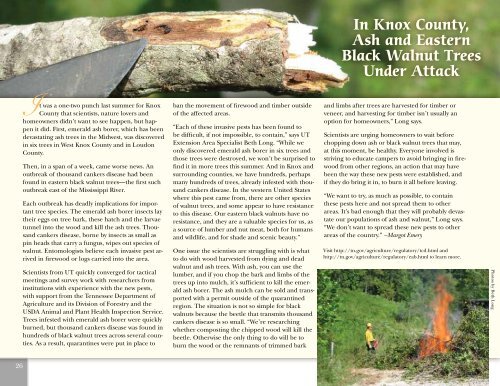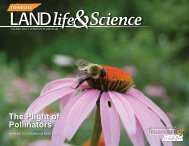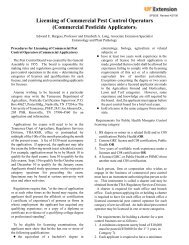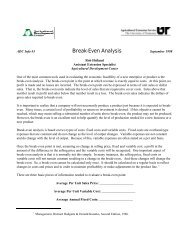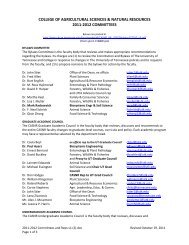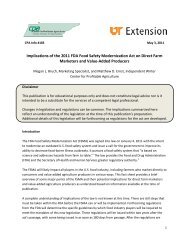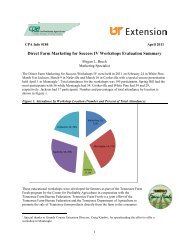Volume 8, Number 1 â Spring/Summer 2011 - The University of ...
Volume 8, Number 1 â Spring/Summer 2011 - The University of ...
Volume 8, Number 1 â Spring/Summer 2011 - The University of ...
You also want an ePaper? Increase the reach of your titles
YUMPU automatically turns print PDFs into web optimized ePapers that Google loves.
In Knox County,Ash and EasternBlack Walnut TreesUnder AttackIt was a one-two punch last summer for KnoxCounty that scientists, nature lovers andhomeowners didn’t want to see happen, but happenit did. First, emerald ash borer, which has beendevastating ash trees in the Midwest, was discoveredin six trees in West Knox County and in LoudonCounty.<strong>The</strong>n, in a span <strong>of</strong> a week, came worse news. Anoutbreak <strong>of</strong> thousand cankers disease had beenfound in eastern black walnut trees—the first suchoutbreak east <strong>of</strong> the Mississippi River.Each outbreak has deadly implications for importanttree species. <strong>The</strong> emerald ash borer insects laytheir eggs on tree bark, these hatch and the larvaetunnel into the wood and kill the ash trees. Thousandcankers disease, borne by insects as small aspin heads that carry a fungus, wipes out species <strong>of</strong>walnut. Entomologists believe each invasive pest arrivedin firewood or logs carried into the area.Scientists from UT quickly converged for tacticalmeetings and survey work with researchers frominstitutions with experience with the new pests,with support from the Tennessee Department <strong>of</strong>Agriculture and its Division <strong>of</strong> Forestry and theUSDA Animal and Plant Health Inspection Service.Trees infested with emerald ash borer were quicklyburned, but thousand cankers disease was found inhundreds <strong>of</strong> black walnut trees across several counties.As a result, quarantines were put in place toban the movement <strong>of</strong> firewood and timber outside<strong>of</strong> the affected areas.“Each <strong>of</strong> these invasive pests has been found tobe difficult, if not impossible, to contain,” says UTExtension Area Specialist Beth Long. “While weonly discovered emerald ash borer in six trees andthose trees were destroyed, we won’t be surprised t<strong>of</strong>ind it in more trees this summer. And in Knox andsurrounding counties, we have hundreds, perhapsmany hundreds <strong>of</strong> trees, already infested with thousandcankers disease. In the western United Stateswhere this pest came from, there are other species<strong>of</strong> walnut trees, and some appear to have resistanceto this disease. Our eastern black walnuts have noresistance, and they are a valuable species for us, asa source <strong>of</strong> lumber and nut meat, both for humansand wildlife, and for shade and scenic beauty.”One issue the scientists are struggling with is whatto do with wood harvested from dying and deadwalnut and ash trees. With ash, you can use thelumber, and if you chop the bark and limbs <strong>of</strong> thetrees up into mulch, it’s sufficient to kill the emeraldash borer. <strong>The</strong> ash mulch can be sold and transportedwith a permit outside <strong>of</strong> the quarantinedregion. <strong>The</strong> situation is not so simple for blackwalnuts because the beetle that transmits thousandcankers disease is so small. “We’re researchingwhether composting the chipped wood will kill thebeetle. Otherwise the only thing to do will be toburn the wood or the remnants <strong>of</strong> trimmed barkand limbs after trees are harvested for timber orveneer, and harvesting for timber isn’t usually anoption for homeowners,” Long says.Scientists are urging homeowners to wait beforechopping down ash or black walnut trees that may,at this moment, be healthy. Everyone involved isstriving to educate campers to avoid bringing in firewoodfrom other regions, an action that may havebeen the way these new pests were established, andif they do bring it in, to burn it all before leaving.“We want to try, as much as possible, to containthese pests here and not spread them to otherareas. It’s bad enough that they will probably devastateour populations <strong>of</strong> ash and walnut,” Long says.“We don’t want to spread these new pests to otherareas <strong>of</strong> the country.” –Margot EmeryVisit http://tn.gov/agriculture/regulatory/tcd.html andhttp://tn.gov/agriculture/regulatory/eab.html to learn more.Photos by Beth Long26


